8A Unit7 Seasons.教案
最新牛津译林初中八年级英语上册 Unit 7 Seasons说课稿

Unit 7 SeasonsReading (1) 说课稿一、说教材(一)教材的地位和作用1. 教学内容分析A poem about the seasons是牛津译林版初中英语8A Unit7 Seasons Reading第一课时。
这是一篇有关四季的优美诗歌,学生在阅读中对季节和天气有一个整体的认知,具备基本的季节变化常识。
学生通过细细品读诗歌的韵律,从中感受到季节的美和大自然的奇妙,从而引导他们爱护自然,保护环境。
2. 教学重、难点教学重点:掌握描述四季特征的词汇和运用句型表达在不同季节所做的事情。
教学难点:用正确的语音、语调朗诵诗歌;运用季节、天气词汇进行日常交际对话。
八年级学生已经具备了单词认读、拼写和一定的阅读能力。
在本课之前,学生已经学习了季节的单词并且能用简单的短语、句子说出在相关季节所做的事情。
(二)教学目标1. 知识目标①掌握有关四季气候和特征的词汇、短语、句型。
掌握单词:shower, upon, temperature, steam, harvest, drop, rise, shade…掌握短语:be full of, fly far away, forget to grow, turn brown…掌握句型:What a perfect time to fly a kite!Farmers work to harvest crops, as the days are shorter and the temperature drops.②熟练吟诵诗歌,把握诗歌节奏,能找出诗歌中押韵的单词。
2. 能力目标①灵活运用句型表述自己在不同季节所做的事情。
②读懂四季小诗,了解四季的变化。
③通过“互动型”教学途径,培养学生的创新精神和将所学的英语运用于日常交际的能力,培养学生的语言能力和自主学习的能力。
3. 情感目标在教学中恰当的渗透保护地球的意识,让学生意识到保护大自然的重要性,并能付诸于行动。
8AUnit7Seasons教案(全)

8AUnit7Seasons教案(全)2)What’theweatherlikeinAutumn3)WhatcanAmydoinummer2.Readaft ertherecorder.3.Praticeinpair.4.Actitout.Step5.E某planation1.Bringmemyclothe,Hobo.bring带来take带走e.g.Pleaebringmemycoat.Takeyourbookhomeafterchool2.You’lllookco olandfeelcoolwithnothingon!lookcool看起来酷3.Whicheaondoyoulikebet,SimonWhichiyourfavouriteeaonlike…bet/fa vourite最喜欢……e.g.IlikepringbetMyfavouriteeaonipring.课后作1.Rememberthenewwordandphraeintheleon.业2.Finihthee某ercieintheworkbook..教后记237910年级课题课型初二学科主备人教材Talkaboutdifferentweather.1.将听的过程进行分解,明确每个阶段的任务。
2.复习引出新的问题,激发学生兴趣,并让学生带着问题听对话材料1113年级课题课型授课教师授课时间初二tak新授课学科主备人教材任教班级英语8Aunit7年月日第周星期主备教师教学设计二次备课教学目标Tolearntoorganizeideaforwritinganarticleforthechoolnewletterand towriteanarticleaboutyourfavouriteeaon.Tolearntoorganizeideaforwritinganarticleforthechool重点难点newletterandtowriteanarticleaboutyourfavouriteeaon.化解重难点的方法与手段Step1.Preentation1.Preentomenewwordwithpictureandthemreadthemal ouddeepadj.深的frozenadj.结冰的landn.陆地e某citingadj.激动人心的throwvt.扔,投,掷nowmann.雪人creamvi.&vt.尖叫,惊呼icen.冰everywhereadv.到处Step2.Litening1.Litentotherecorderandanwerthefollowingquetion.1 .Whatithewriter’favouriteeaonWinter.2.WhatitheweatherlikeIt’v erycold.Thetemperatureiuuallybelowzeroanditioftennowy.3.Whatdoe HarbinlooklikeEverythingicoveredindeepwhitenow,andthelakeandriv erarefrozen.4.WhydoethewriterlikethieaonBecauethewriterloveplay ingoutide.5.WhatactivitiedopeopleenjoydoinginthieaonTheyhavebig nowballfight.Theythrownowballateachother,creamingandlaughing.Th eyalomakenowmenandue14通过大量的练习来巩固本单元所学知识。
牛津英语八上Unit7 Seasons reading教案
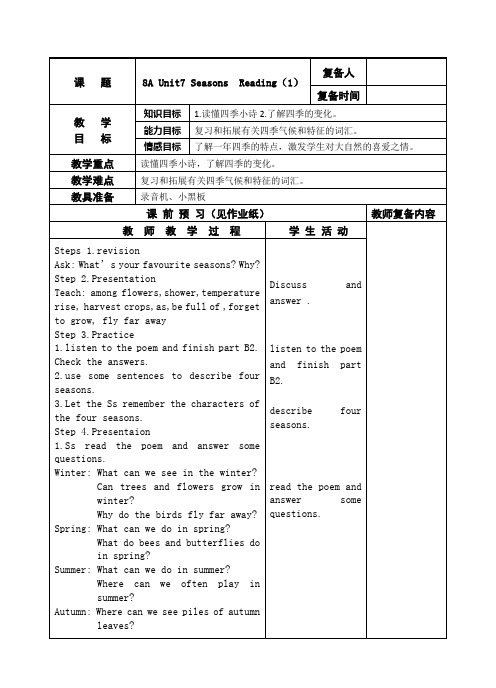
Why do the birds fly far away?
Spring: What can we do in spring?
What do bees and butterflies do
in spring?
Summer: What can we do in summer?
2.finish partB2.check the answers.
3.finish partB3.check the answers.
4.Ss read after the tape, and then divide
Ss into four groups .Each group will read one of the season.
(1)Winter: Trees and flowers forgot to grows.
(2)Spring: Bees and butterflies play among flowers.
They hide from the April shows.
Step5.Practice
1.finish partB1.check the answers.
rise, harvest crops,as,be full of ,forget to grow, fly far away
Step 3.Practice
1.listen to the poem and finish part B2.
Check the answers.
e some sentences to describe four seasons.
课题
8AUnit7 SeasonsReading(1)
8A Unit 7 Seasons 微课
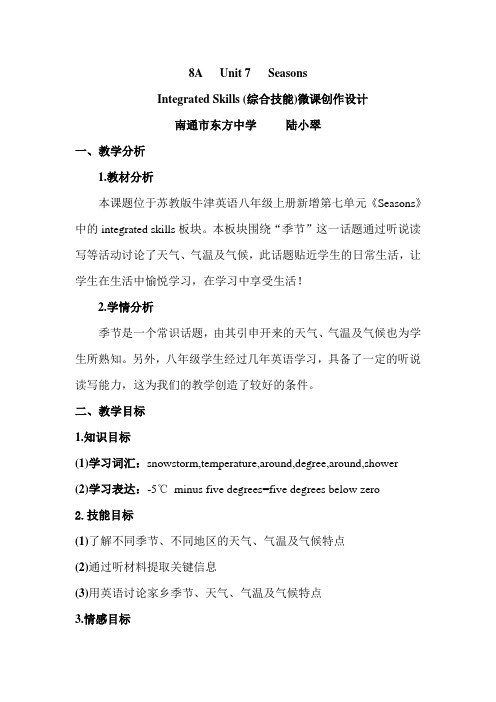
8A Unit 7 SeasonsIntegrated Skills (综合技能)微课创作设计南通市东方中学陆小翠一、教学分析1.教材分析本课题位于苏教版牛津英语八年级上册新增第七单元《Seasons》中的integrated skills板块。
本板块围绕“季节”这一话题通过听说读写等活动讨论了天气、气温及气候,此话题贴近学生的日常生活,让学生在生活中愉悦学习,在学习中享受生活!2.学情分析季节是一个常识话题,由其引申开来的天气、气温及气候也为学生所熟知。
另外,八年级学生经过几年英语学习,具备了一定的听说读写能力,这为我们的教学创造了较好的条件。
二、教学目标1.知识目标(1)学习词汇:snowstorm,temperature,around,degree,around,shower(2)学习表达:-5℃minus five degrees=five degrees below zero2.技能目标(1)了解不同季节、不同地区的天气、气温及气候特点(2)通过听材料提取关键信息(3)用英语讨论家乡季节、天气、气温及气候特点3.情感目标让学生热爱家乡,关心天气,关心环境,增强保护环境的意识三、教学重难点(1)教学重点:从听力材料中获取有用的、准确的信息(2) 教学难点: 用英语讨论季节、天气、气温等四、教学媒体的选择和设计本节课以课件为辅助教学手段,加上这是一节英语综合课,要培养学生英语听说读写的语言综合技能,所以其中插入了天气预报的音频,对话音频及恶劣环境的视频,既直观形象,又有美感,从而调动学生的多种感官,激发学生的学习兴趣。
五、教学过程1.Free talk导入. 学生通过回答一些问题了解本节课话题2.通过介绍南通四个季节学习本课重要词汇3.学生阅读P87 A1部分,根据不同表述写出对应季节4.学生听P87 A2部分播报的天气预报,提取关键信息完成表格5.学生听材料,完成P88 A36.听Daniel和Aunt的对话完成T/F 并提炼重要表达方式7.Pair work: 学生和同伴讨论旅游去处的选择及原因8. Group work: 学生小组讨论如何保护环境课堂小结我对教材中的部分内容进行了整合,比如把文本形式转换为表格形式,让学生更清晰地了解材料。
8A Unit 7 Seasons教学设计-优秀教案
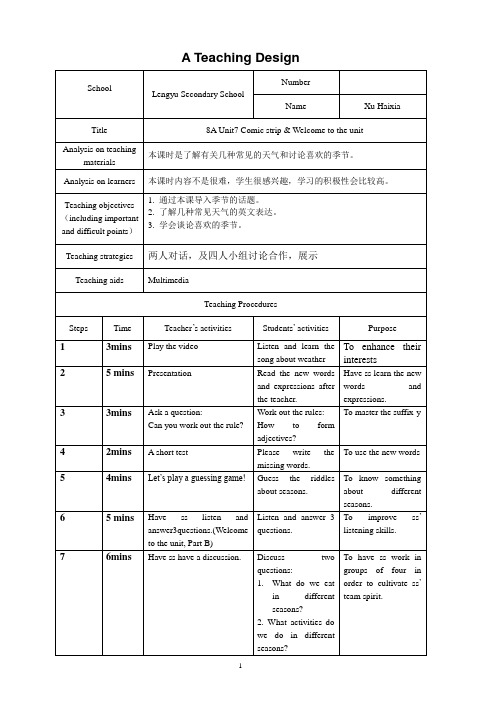
3mins
Ask a question:
Can you work out the rule?
Work out the rules:
Howto form adjectives?
To master the suffix-y
4
2mins
A short test
Please write the missing words.
Listen and answer3questions.
To improve ss’listening skills.
10
4 mins
Have ss practice Hobo and Eddie’s dialogue in pairs.
Work in pairs to practice and act out the dialogue.
To use the new words
5பைடு நூலகம்
4mins
Let’s play a guessing game!
Guess the riddles about seasons.
To know something aboutdifferent seasons.
6
5 mins
Have sslisten and answer3questions.(Welcome to the unit, Part B)
Teaching strategies
两人对话,及四人小组讨论合作,展示
Teaching aids
Multimedia
Teaching Procedures
Steps
Time
Teacher’s activities
Students’activities
牛津译林版英语八上Unit 7《Seasons》(task)教学设计1
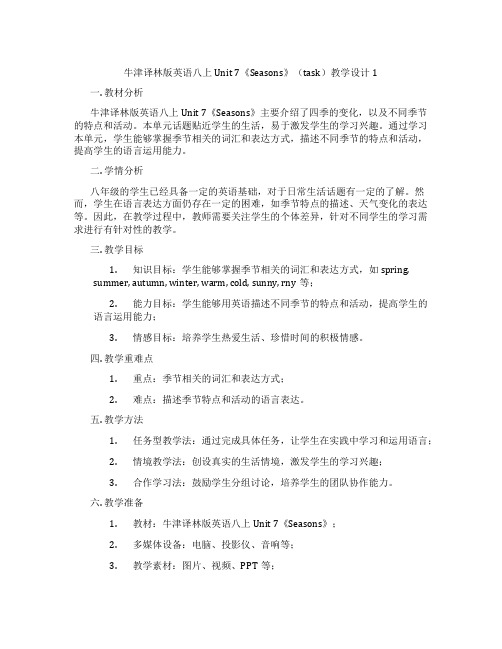
牛津译林版英语八上Unit 7《Seasons》(task)教学设计1一. 教材分析牛津译林版英语八上Unit 7《Seasons》主要介绍了四季的变化,以及不同季节的特点和活动。
本单元话题贴近学生的生活,易于激发学生的学习兴趣。
通过学习本单元,学生能够掌握季节相关的词汇和表达方式,描述不同季节的特点和活动,提高学生的语言运用能力。
二. 学情分析八年级的学生已经具备一定的英语基础,对于日常生活话题有一定的了解。
然而,学生在语言表达方面仍存在一定的困难,如季节特点的描述、天气变化的表达等。
因此,在教学过程中,教师需要关注学生的个体差异,针对不同学生的学习需求进行有针对性的教学。
三. 教学目标1.知识目标:学生能够掌握季节相关的词汇和表达方式,如spring,summer, autumn, winter, warm, cold, sunny, rny等;2.能力目标:学生能够用英语描述不同季节的特点和活动,提高学生的语言运用能力;3.情感目标:培养学生热爱生活、珍惜时间的积极情感。
四. 教学重难点1.重点:季节相关的词汇和表达方式;2.难点:描述季节特点和活动的语言表达。
五. 教学方法1.任务型教学法:通过完成具体任务,让学生在实践中学习和运用语言;2.情境教学法:创设真实的生活情境,激发学生的学习兴趣;3.合作学习法:鼓励学生分组讨论,培养学生的团队协作能力。
六. 教学准备1.教材:牛津译林版英语八上Unit 7《Seasons》;2.多媒体设备:电脑、投影仪、音响等;3.教学素材:图片、视频、PPT等;4.课堂活动用品:卡片、贴纸等。
七. 教学过程1.导入(5分钟)教师通过展示四季变化的图片,引导学生谈论各自喜欢的季节,激发学生的学习兴趣。
2.呈现(10分钟)教师利用PPT展示本节课的主要内容,包括季节词汇和描述季节特点的句子。
同时,教师引导学生跟读,注意发音和语调。
3.操练(15分钟)教师学生进行小组活动,用所学的词汇和句子描述各自喜欢的季节。
8A Unit7Seasons.(第三,四课时)
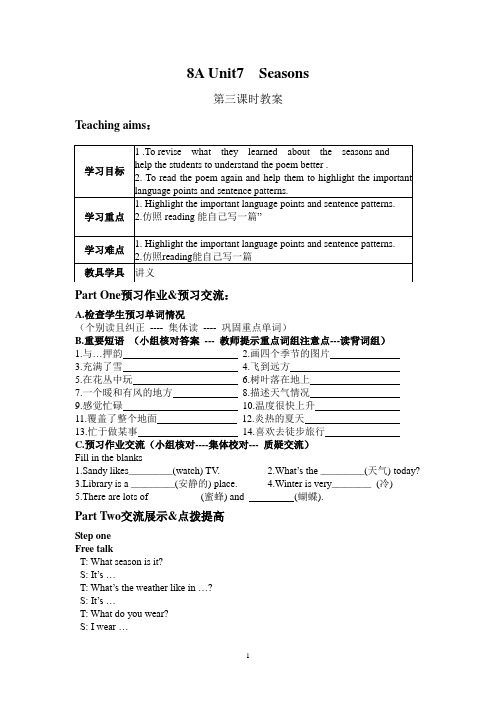
8A Unit7 Seasons第三课时教案Teaching aims:Part One预习作业&预习交流:A.检查学生预习单词情况(个别读且纠正---- 集体读---- 巩固重点单词)B.重要短语(小组核对答案--- 教师提示重点词组注意点---读背词组)1.与…押韵2.画四个季节的图片3.充满了雪4.飞到远方5.在花丛中玩6.树叶落在地上7.一个暖和有风的地方8.描述天气情况9.感觉忙碌10.温度很快上升11.覆盖了整个地面12.炎热的夏天13.忙于做某事14.喜欢去徒步旅行C.预习作业交流(小组核对----集体校对--- 质疑交流)Fill in the blanks1.Sandy likes__________(watch) TV.2.What’s the __________(天气) today?3.Library is a __________(安静的) place.4.Winter is very__________(冷)5.There are lots of __________(蜜蜂) and (蝴蝶).Part Two交流展示&点拨提高Step oneFree talkT: What season is it?S: It’s …T: What’s the weather like in …?S: It’s …T: What do you wear?S: I wear …T: What can you do in…?S: I can… (师生互动)Review the poem (重温一下诗歌)Step twoLanguage points1. be full of 充满e.g. The hall is full of people.2. far away 遥远,远方e.g. We are going to a place far away.I know you are far away, but I need help.3. a perfect time to do sth 做某事的极好时间e.g. The morning is a perfect time to do some reading.4. hide from 躲避5. feel +adj 感到。
牛津译林版英语八上Unit 7《Seasons》(gramma)教学设计1

牛津译林版英语八上Unit 7《Seasons》(gramma)教学设计1一. 教材分析牛津译林版英语八上Unit 7《Seasons》主要介绍四季的变化,包括春季、夏季、秋季和冬季的特点。
通过学习本单元,学生能够掌握四季的英文表达,描述四季的变化和特点,以及运用季节相关的词汇和句型进行交流。
本节课的教学内容主要包括词汇的学习、句型的练习和听力理解。
二. 学情分析八年级的学生已经具备了一定的英语基础,能够听懂并运用简单的英语进行交流。
但是,对于一些季节相关的词汇和表达可能比较陌生,需要通过图片、视频等直观的方式进行学习。
同时,学生对于天气和季节的变化有一定的了解,可以借助自己的生活经验进行学习。
三. 教学目标1.能听懂、会说、会读本节课的生词和句型。
2.能用英语简单描述四季的变化和特点。
3.能通过听力理解,获取有关季节的信息。
4.培养学生的观察力和表达能力。
四. 教学重难点1.重点:掌握四季的英文表达,能够用英语描述四季的变化和特点。
2.难点:对于一些季节相关的词汇和表达的理解和运用。
五. 教学方法采用任务型教学法,通过图片、视频、听力材料等直观的方式引导学生学习,结合小组合作、讨论等互动方式,激发学生的学习兴趣,提高学生的参与度。
六. 教学准备1.教材:牛津译林版英语八上Unit 7《Seasons》。
2.教具:PPT、图片、视频、听力材料等。
3.课前准备:让学生观察四季的图片,准备相关的听力材料。
七. 教学过程1.导入(5分钟)通过展示四季的图片,引导学生观察并说出自己最喜欢的季节,激发学生的学习兴趣。
2.呈现(10分钟)利用PPT展示本节课的生词和句型,让学生听懂并能够正确朗读。
同时,通过图片和视频的形式,让学生直观地理解四季的变化和特点。
3.操练(10分钟)将学生分成小组,进行角色扮演,模拟四季的变化场景,让学生运用所学的词汇和句型进行交流。
4.巩固(5分钟)通过听力材料,让学生听懂并能够理解有关季节的信息。
英语教案Teaching Plan for 8A Unit 7 Seasons
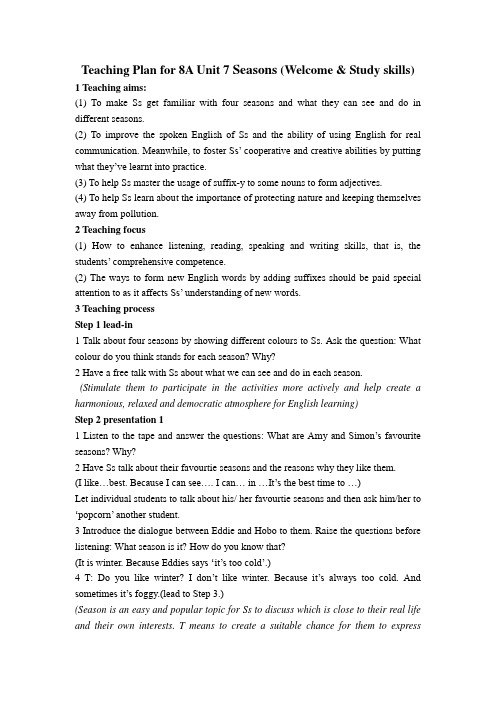
Teaching Plan for 8A Unit 7 Seasons (Welcome & Study skills) 1 Teaching aims:(1) To make Ss get familiar with four seasons and what they can see and do in different seasons.(2) To improve the spoken English of Ss and the ability of using English for real communication. Meanwhile, to foster Ss‟ cooperative and creative abilities by putting what they‟ve learnt into practice.(3) To help Ss master the usage of suffix-y to some nouns to form adjectives.(4) To help Ss learn about the importance of protecting nature and keeping themselves away from pollution.2 Teaching focus(1) How to enhance listening, reading, speaking and writing skills, that is, the students‟ comprehensive competence.(2) The ways to form new English words by adding suffixes should be paid special attention to as it affects Ss‟ understanding of new words.3 Teaching processStep 1 lead-in1 Talk about four seasons by showing different colours to Ss. Ask the question: What colour do you think stands for each season? Why?2 Have a free talk with Ss about what we can see and do in each season. (Stimulate them to participate in the activities more actively and help create a harmonious, relaxed and democratic atmosphere for English learning)Step 2 presentation 11 Listen to the tape and answer the questions: What are Amy and Simon‟s favourite seasons? Why?2 Have Ss talk about their favourtie seasons and the reasons why they like them.(I like…best. Because I can see…. I can… in …It‟s the best time to …)Let individual students to talk about his/ her favourtie seasons and then ask him/her to …popcorn‟ another student.3 Introduce the dialogue between Eddie and Hobo to them. Raise the questions before listening: What season is it? How do you know that?(It is winter. Because Eddies says …it‟s too cold‟.)4 T: Do you like winter? I don‟t like winter. Because it‟s always too cold. And sometimes it‟s foggy.(lead to Step 3.)(Season is an easy and popular topic for Ss to discuss which is close to their real life and their own interests. T means to create a suitable chance for them to expressthemselves in English. At the end of this period, T introduces a new word ‘foggy’ to lead to suffixes in the next teaching period.)Step 3 presentation 21 Talk about different weather with the help of several pictures. Ask Ss to finish PartA on Page 81.2 Show more examples about suffix …-y‟ and encourage Ss to work out the rules. (three rules: 1. Add –y directly 2. Double the last consonant and then add –y 3. Omit …e‟ and then add -y)3 Play a game “Which balloon is gone” to get Ss to find out the missing words in a very short time.4 Play another game “noun or adjectives”. It a noun is shown, girls stand up quickly. If an adjective is shown, boys stand up quickly. In this way, Ss are required to master the parts of speech of words as quickly as they can.5 Changzhou has different weather all year round. Help Ss describe it with correct words formed by …-y‟ by completing the exercises on Page 89.(This part mainly deals with the usage of suffix ‘-y’ by showing pic tures and examples. Ss are encouraged to work out the rules by themselves and use them while describing the weather in Changzhou. )Step 4 practice1. A weather broadcaster is wanted at Panjia Middle School TV Station. If you cancomplete the following tasks successfully, you will have the chance to have a-week stay there.Task 1: weather sign (look at the sign and name it in English)Task 2: exercises about words on weather (fill in the blanks with the right forms) Task 3: make a real weather broadcast about Changzhou(Ss are encouraged to complete different tasks with various forms and difficulties to master the teaching focus. Meanwhile, they are also able to gain confidence, enhance abilities through real English practice.)2.Discuss the weather conditions nowadays to let Ss be aware of the seriouspollution problems we are facing. Thus, make Ss realize the importance of protecting nature and the ways of keeping themselves away from pollution.Step 5 Homework1 Make a report about the weather in Changzhou in four seasons.2 Write about their own favourtie seasons.。
8AUnit7Seasons教学设计
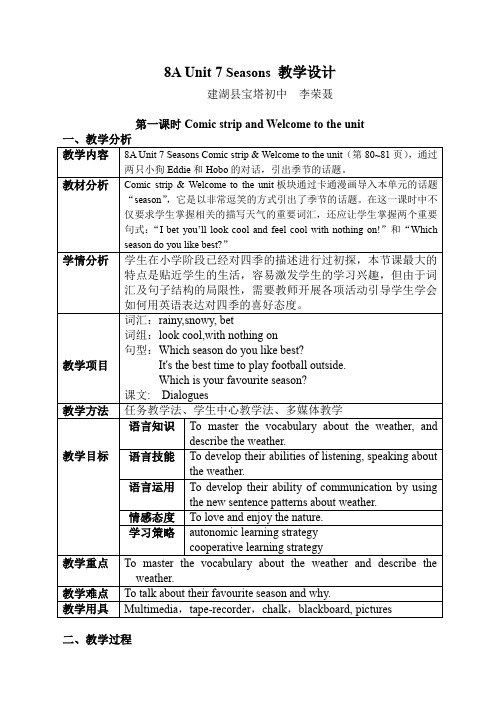
从学生生活 实际出发, 创设情境, 鼓励学生活 学活用所学 语言知识, 大胆创新和 时间提高口 语表达能 力,勇于展 示自我。 适当合理的 家庭作业既 能及时巩固 当天所学内 容达到温故 而知新,同 时将课内外 阅读相融 合,有利于 学生阅读能 力提升及长 远发展。
第二课时 Reading 1
一、教学分析 教学内容 Reading(第 82 页),本课时主要学习 Reading A 文章的内容。 教材分析 Reading 板块通过一篇描写四季的诗歌,体会诗歌的“意象美、
8A Unit 7 Seasons 教学设计
建湖县宝塔初中 李荣聂
第一课时 Comic strip and Welcome to the unit 一、教学分析
教学内容 8A Unit 7 Seasons Comic strip & Welcome to the unit(第 80~81 页),通过
译林版8A unit 7 Seasons(Reading)教学设计

练习学生的听力,让学生通过听诗歌,欣赏诗歌的美。
教学过程
环节
教学内容
教师活动
学生活动
信息技术手段
环节一
Warming- up(enjoy a music)
Play a music called “秋日私语” for the students, then have a free talk.
Read the poem by themselves and feel the tone of the poem.
环节三
While-reading
1 Listen to the tape. Enjoythe poem. Different people likedifferent seasons .Let’s enjoy the poem.
1.Are you familiar with the music?
2.Do you know the name of it is?
3.What season does “autumn whisper” tell?
So together with the music, let’s go on our trip through the four seasons. Ok, today we will learn a poem about seasons of the year. Are you ready to read it? First, open your book to page 82.
环节六
Homework
1. Read the poem and remember the new words, phrasesand sentences
8A_Unit7_Seasons教案__(全)
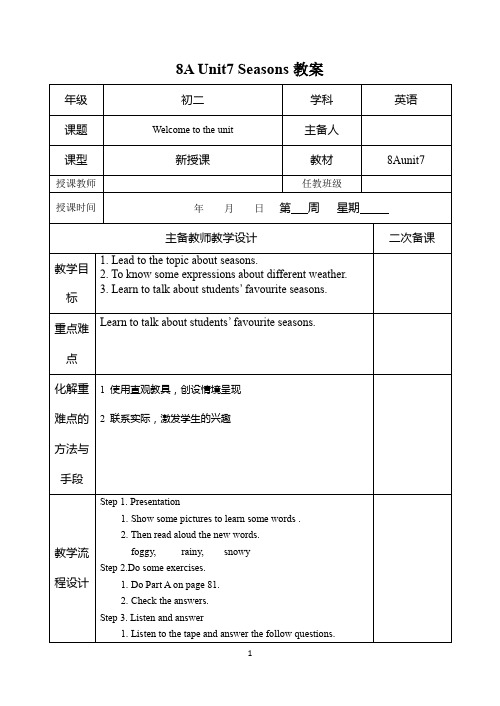
T: Yes, the leaves turn red, yellow, golden and brown in autumn, and they fall intopilesuponthe ground. This is a pile of leaves.What do farmers do? Do they harvest crops? Farmersharvest cropsin Autumn.
Step 3. Listen and answer
1. Listen to the tape and answer the follow questions.
1) What does Eddie ask hobo to do?
2) Is it cold today?
3) Does hobo think Eddie look cool?
T: Now, let’s match. Group One, read description A together, which season? ……
2.(快速找读,完成练习B3)
T: This time, please read the passage quickly and silently, and then find out six mistakes in Shirley and Amy’s conversation. Please read.两分钟之后Now, you can discuss in groups, try to find out the mistakes and correct them.
1) Which season does Simon like best?
8AUnit7 Seasons教案

Teaching planUnit 7 SeasonsPeriod One: Comic strip and welcome to the unitI. Teaching aims1. Knowledge and skills1) KnowledgeWords: rainy snowy bet foggyPhrases: look cool with nothing onSentences: Which season do you like best?It’s the best time to play football outside.Which is your favourite season?2) SkillsListen: The students can get the general idea and some more details by listening.Speak: They can talk about their favourite weather and seasons with their partners in English.Read: They can read the texts correctly and fluently and they can read after the tape and pay attention to their pronunciation andintonation.Write: They can write a composition about their favourite season.2. Process and methods1) Play a song to the students and encourage them to sing after the videotogether.2) Ask and answer. In this part, students can learn how to ask the weather and how to answer it.3) Present the pictures of different seasons and lead students to judge which seasons they are and what weather is like in each season and think about what they can do in each season.4) Practice the conversation with their partners about their preference to the seasons.5) Write a composition about their favourite seasons.3. Emotion, attitude and value1) Arouse the students’ interest in seasons and weather and educate them to find the beauty in each season.2) Advise them to keep safe when they do activities in some special weather.II. Teaching key and difficult points1. Key points:1) The relevant words, phrases and sentence structures.2) Be able to talk about the weather and seasons with their partners.2. Difficult points1) Encourage students to write a composition about their favouriteseasons.2) Think about different activities they can do in different seasons.III. Teaching methods1. Multimedia teaching method.2. Communicational teaching method.3. Task- based teaching method.IV. Teaching aidsMultimedia tape- recorder PPTV. Teaching type: Listening and speaking lessonVI. Teaching proceduresStep1. Lead- in1. Ask and answer:Do you like the study?Do you like studying English?Do you like me?Purpose: By asking these questions, the teacher can arouse the students’interest in learning English and grasp their attention easily.2. Ask something about the weather:T: What’s the weather like today? / How’s the weather?T: Do you like this weather? Why?T: What can you do in this weather?3. Play a song. The teacher plays a song How’s the weather to students and encourager them to sing it together.4. Conclude: How many kinds of weather are there in this song? What arethey? Let’s get to know them one by one.Step2. Presentation1. Present three kinds of weather they have learnt to them: sunny, cloudy and windy.In this period, the teacher can ask some questions as follows:—What’s the weather like in this picture?—Do you like a sunny day?—What can you do in a sunny day?2. Present three more kinds of weather: rainy, foggy and snowy.In this part, the teacher can also prepare some questions:Rainy: What should you take or wear when it rains?Foggy: Which city is famous for its foggy weather in Britain? What about in China?Can you see clearly in a foggy day?Can you drive your car or ride you bike so quickly in a foggyday?Snowy: Do you like a snowy day?What can you do in a snowy day?3. Lead the student to read these words about weather and ask them to pay attention to the pronunciation. Then check if they can read these words correctly. If wrong, help them to correct in time. In this part, the teacher can present 6 pictures of these 6 kinds of weather to thestudents and point one then they should judge what weather it is.4. Extent more kinds of weather.Present 3more pictures and some questions to help them guess what the weather is like in each picture.Frozen: When will water change into ice?Frosty: Which season will have a frosty day?What can you see in the tree branches and grasses? Stormy: Is the rain heavy and the wind strong in a storm day?Which season do stormy days happen in?5. Work out the rules that some nouns change into adjectives by adding the suffix- y.sun + y —sunnywind+ y —windycloud + y —cloudyrain + y —rainysnow + y —snowyfrost + y —frostystorm + y —stormyStep4. Practice1. Do a relay race. The first student will show the second student a weather card and ask him or her the question “ What’s the weather like? / How’s the weather?” The second student will answer the question andthen ask the third student the same question. Which group complete the game in the shortest time is the winner.2. Hold a short discussion with their groupmates:How’s the weather in each season?Step5. Presentation1. Present 4 pictures of seasons and prepare some similar questions to help students to get further known about seasons:What colour is each season?What’s the weather like in each season?What can you see in each season?What can you do in each season?2. Teach students a sentence structure :It’s the best time for sb. to do sth.It’s the best time for doing sth.3. Complete the blanks according to the pictures using the sentencestructure above.Step6. Practice1. Play a listening material to students twice and ask them to find out thedetails to fill in the blanks.2. Check the answers.3. Divide the whole class into 2 parts. The first part acts Amy and thesecond part acts Simon. Then exchange the roles.4. Encourage students to make a similar conversation with their partnersaccording to the model on page81. Finally, invite some pairs to show their conversations.Step7. Emotional educationWe have four seasons and we can do many activities in each season.But we must keep away from danger.Picture1: In spring, we like to fly kites. But please fly kites far away from the electric wire, especially the high voltage.Picture2: In summer, most of you like swimming. But please don’t swim alone in a deep river or lake.Picture3: In winter, you like skating or skiing. You must be more careful or you’ll fall down easily.Step8. ProductionEncourage students to write a composition about their favourite season.Task: 1. Each group will be asked to describe one season.2. Each group will get a paper sheet and they can complete thecomposition with their groupmates.3. Each group write will choose one student to read and showtheir composition.4. Which group will write best and fastest will be the winner andget the present.Step9. Comic strip1. Present the pictures and ask 3 questions as follows:1) How’s the weather?2) What does Eddie want to do?3) Does Eddie look cool with the clothes?2. Play the video twice and check the answers.3. Analyze the key points.bet with nothing on4. Ask the students to read the text in roles and then invite some pairsto act it out .5. Play a song video We wish you a Merry Christmas to students andencourage them to sing it together.T: Today is Dec 15th. Ten days later is Christmas Day. I wish all of you to have a happy Christmas Day! Now close your eyes and make a wish together now. OK, please keep it in your heart and Ihope your wishes can come true one day. Ok, that’s all for today’slesson. Goodbye, see you tomorrow!Step10. Homework1. Remember and recite the words, phrases and sentence structures in this period.2. Try to talk about the seasons and weather in daily life.3. Ask students to write a composition about their favourite season by themselves. Then try to make a poster to introduce their favourite season.4. Preview Reading part.。
牛津译林版八年级上册(初二上学期,8A) Unit7 Seasons教案
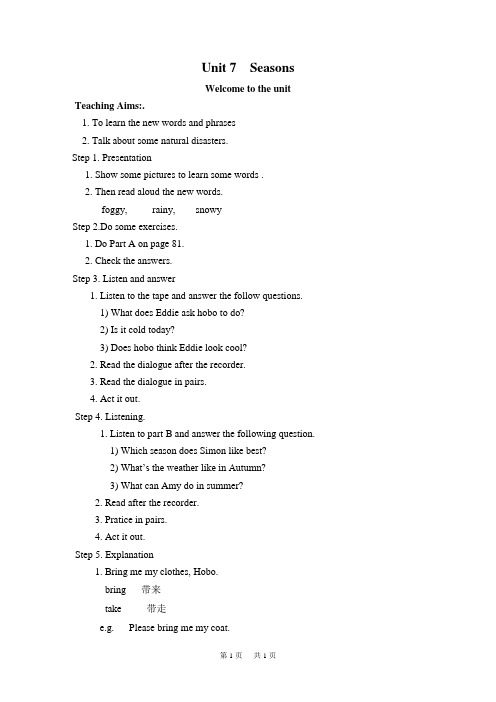
Unit 7 SeasonsWelcome to the unit Teaching Aims:.1. To learn the new words and phrases2. Talk about some natural disasters.Step 1. Presentation1. Show some pictures to learn some words .2. Then read aloud the new words.foggy, rainy, snowyStep 2.Do some exercises.1. Do Part A on page 81.2. Check the answers.Step 3. Listen and answer1. Listen to the tape and answer the follow questions.1) What does Eddie ask hobo to do?2) Is it cold today?3) Does hobo think Eddie look cool?2. Read the dialogue after the recorder.3. Read the dialogue in pairs.4. Act it out.Step 4. Listening.1. Listen to part B and answer the following question.1) Which season does Simon like best?2) What’s the weather like in Autumn?3) What can Amy do in summer?2. Read after the recorder.3. Pratice in pairs.4. Act it out.Step 5. Explanation1. Bring me my clothes, Hobo.bring 带来take 带走e.g. Please bring me my coat.Take your book home after school2. You’ll look cool and feel cool with nothing on!look cool 看起来酷3. Which season do you like best, Simon?Which is your favourite season?like … best / favourite 最喜欢……e.g. I like spring bestMy favourite season is spring.Step 6. Exercises根据汉语提示或所给词的正确形式填空。
牛津译林版八年级英语上册8AUnit7单元教案

牛津译林版八年级英语上册8A Unit 7 单元教案一、教学内容本节课我们将学习牛津译林版八年级英语上册8A Unit 7的教材内容。
具体包括:Reading部分的“Seasons of the year”和“Which season do you like best?”,以及Grammar部分的“Present continuous tense”。
二、教学目标1. 学生能够理解并掌握描述四季变化的词汇和表达方式。
2. 学生能够运用现在进行时描述正在进行的动作。
3. 学生能够通过阅读文章,了解不同季节的特点和活动。
三、教学难点与重点重点:现在进行时的用法以及描述四季变化的词汇。
难点:正确运用现在进行时描述正在进行的动作。
四、教具与学具准备1. 教具:PPT,展示四季变化的图片和动画。
2. 学具:学生准备笔、纸和英语课本。
五、教学过程1. 导入:通过展示四季变化的图片,引导学生谈论不同季节的特点。
2. 阅读理解:学生阅读“Seasons of the year”和“Which season do you like best?”,回答相关问题。
3. 语法讲解:讲解现在进行时的构成和用法,结合例句进行说明。
4. 例题讲解:给出几个句子,让学生判断是否使用了正确的时态,并解释原因。
5. 随堂练习:学生进行现在进行时的句子练习,教师给予指导。
6. 小组活动:学生分组讨论,运用现在进行时描述组内成员正在进行的动作。
六、板书设计1. 四季变化词汇:spring, summer, autumn, winter, warm, hot, cool, cold, etc.2. 现在进行时:be + doing3. 例句:The children are playing in the park.(孩子们正在公园里玩耍。
)七、作业设计1. 作业题目:请用现在进行时描述下列场景。
a. Your friends are having a picnic in the park.b. Your parents are watching TV at home.c. The teacher is explaining the lesson to the students.答案:a. My friends are having a picnic in the park, enjoying the beautiful spring weather.b. My parents are watching TV at home, relaxing after a long day at work.c. The teacher is explaining the lesson to the students, making sure they understand the key points.2. 课后阅读:阅读一篇关于四季变化的文章,用现在进行时描述文章中的场景。
牛津译林版英语八上Unit 7《Seasons》(integrated skills)教学设计1
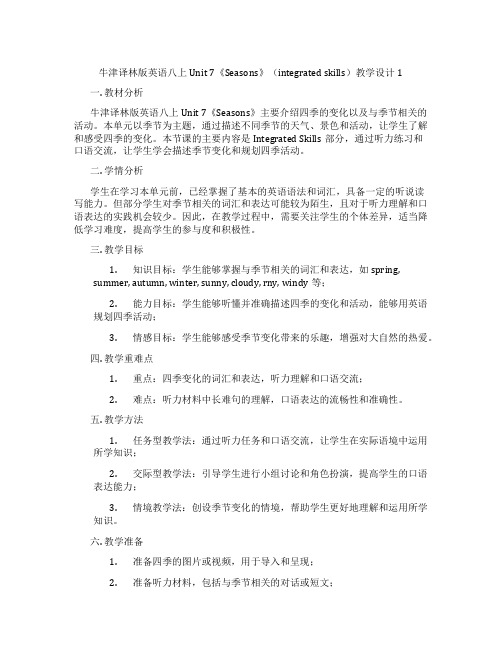
牛津译林版英语八上Unit 7《Seasons》(integrated skills)教学设计1一. 教材分析牛津译林版英语八上Unit 7《Seasons》主要介绍四季的变化以及与季节相关的活动。
本单元以季节为主题,通过描述不同季节的天气、景色和活动,让学生了解和感受四季的变化。
本节课的主要内容是Integrated Skills部分,通过听力练习和口语交流,让学生学会描述季节变化和规划四季活动。
二. 学情分析学生在学习本单元前,已经掌握了基本的英语语法和词汇,具备一定的听说读写能力。
但部分学生对季节相关的词汇和表达可能较为陌生,且对于听力理解和口语表达的实践机会较少。
因此,在教学过程中,需要关注学生的个体差异,适当降低学习难度,提高学生的参与度和积极性。
三. 教学目标1.知识目标:学生能够掌握与季节相关的词汇和表达,如spring,summer, autumn, winter, sunny, cloudy, rny, windy等;2.能力目标:学生能够听懂并准确描述四季的变化和活动,能够用英语规划四季活动;3.情感目标:学生能够感受季节变化带来的乐趣,增强对大自然的热爱。
四. 教学重难点1.重点:四季变化的词汇和表达,听力理解和口语交流;2.难点:听力材料中长难句的理解,口语表达的流畅性和准确性。
五. 教学方法1.任务型教学法:通过听力任务和口语交流,让学生在实际语境中运用所学知识;2.交际型教学法:引导学生进行小组讨论和角色扮演,提高学生的口语表达能力;3.情境教学法:创设季节变化的情境,帮助学生更好地理解和运用所学知识。
六. 教学准备1.准备四季的图片或视频,用于导入和呈现;2.准备听力材料,包括与季节相关的对话或短文;3.准备季节活动的任务单,用于巩固和拓展;4.准备黑板和粉笔,用于板书。
七. 教学过程1.导入(5分钟)利用四季的图片或视频,引导学生谈论四季的变化和特点,激发学生的学习兴趣。
江苏省扬州市邗江区杨寿学校牛津译林版英语8A Unit 7 seasons Integrated skills教案
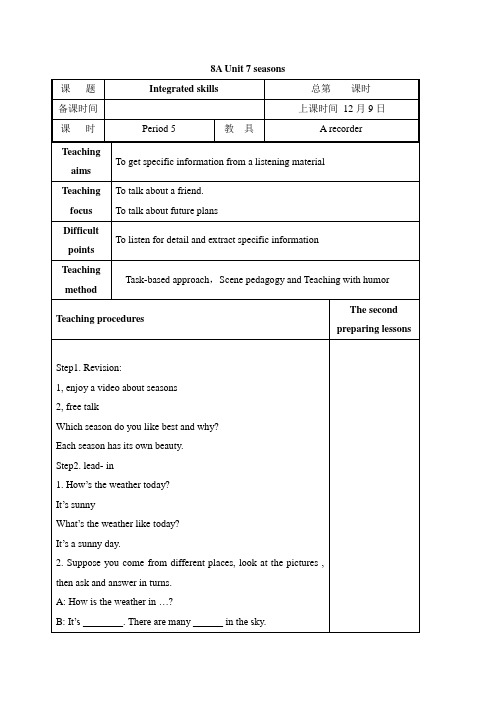
To talk about future plans
Difficult points
To listen for detail and extract specific information
Teaching method
Task-based approach,Scene pedagogy and Teaching with humor
8A Unit 7 seasons
课题
Integrated skills
总第课时
备课时间
上课时间12月9日
课时
Period 5
教具
A recorder
Teaching aims
To get specific information from a listening material
Teaching focus
Teaching procedures
The second
preparing lessons
Step1. Revision:
1, enjoy a video about seasons
2, free talk
Which season do you like best and why?
Each season has its own beauty.
Provide some possible questions
1What will the weather be like in Beijing?
2What will the weather be like in Haikou?
3What will the weat lead- in
- 1、下载文档前请自行甄别文档内容的完整性,平台不提供额外的编辑、内容补充、找答案等附加服务。
- 2、"仅部分预览"的文档,不可在线预览部分如存在完整性等问题,可反馈申请退款(可完整预览的文档不适用该条件!)。
- 3、如文档侵犯您的权益,请联系客服反馈,我们会尽快为您处理(人工客服工作时间:9:00-18:30)。
8A Unit7 Seasons
Reading 1
教学目标
1.知识目标:①掌握有关四季气候和特征的词汇、短语、句型。
②熟练吟诵诗歌,把握诗歌节奏,能找出诗歌中押韵的单词。
2.能力目标:①灵活运用句型表述自己在不同季节所做的事情。
②读懂四季小诗,了解四季的变化。
③通过“互动型”教学途径,培养学生的创新精神和将所学的英语运用于日常交际的能力,培养学生的语言能力和自主学习的能力。
3.情感目标:在教学中恰当的渗透保护地球的意识,让学生意识到保护大自然的重要性,并能付诸于行动。
教学重、难点
1.掌握描述四季特征的词汇和运用句型表达在不同季节所做的事情。
2.用正确的语音、语调朗诵诗歌;运用季节、天气词汇进行日常交际对话。
教学过程
Step1 Warm-up
Greetings
T: Hello, boys and girls, nice to see you.
S: Nice to see you.
T: I’m happy to be your teacher this class, I hope you can have a good time. I prepare an English cartoon for you. Let’s enjoy. And tell me what it is about.(观看有关季节的视频)
Step2: presentation
Talk about their favourite seasons.
T: What is it about? S: four seasons.
T: Which is your favourite season? (问几个学生?) (Who likes summer best? Can you share your sweet memories of summer days?)
板书学生说到的书上相关短语。
T:Thank you for sharing your sweet memories of favourite seasons. In fact, each season has its own beauty and sweet memories.
Step3: watching and reading
1.观看视频感受四季的美
T: Now, let’s enjoy a poem about seasons to feel the beauty of each season together.
2.读,感受诗歌中的押韵美。
T: Do you find the poem about seasons beautiful? Let’s enjoy the beauty together. Open your books to P82. Please read the first part together.
Winter days are full of snow, When trees and flowers forget to grow,
And the birds fly far away To find a warm and sunny day.
T: What can you find between snow and grow?
S: They rhyme with each other
T: Can you find more like this? (第一二组读第二部分,三四组第三部分,全班最后一段)
补:I want you to read the poem to feel the beauty of rhyme again.
3.跟读并发现优美的词或句子。
T: Besides rhyme, do you find the language beautiful? (学生说不出来就说(Never mind)). Let’s read after the video and feel if the language beautiful.
T: Now I’ll give you two min to discuss in groups and try to find some beautiful words or sentences.
4.朗读比赛
T: We enjoyed the beauty of each season. Now it’s time to express the poem with your own feelings in groups. . Please read the poem correctly, clearly and emotionally. And you should also pay attention to your pronunciation, intonation Then each group choose one student to read. Let’s see who has the best voice
读后评价Wonderful. The poem is beautiful, you read wonderfully and the seasons are really interesting.
Step4: Have a competition
1.完成短文
T:Each season is lovely and beautiful.
4.谈论自己喜欢的季节。
T:Can you talk about your favourite seasons
The weather looks like/The reason you like it:/People’s activities Your favourite season/
Step5: Activity(欣赏)
T: Here is another poem about seasons. Let’s enjoy the beauty together.
Spring is green with flower and song,
Summer is hot and days are long,
Autumn is rich with fruit and grain,
Winter brings snow and the New Year again.
Seasons change,with all kinds of scenes,
We are lucky to have wonderful dreams.
Seasons change, as rivers flow,
When we draw the trees grow.
Thanks to seasons,
And thanks to the earth,
Life becomes colorful at every sunrise.
let's protect the nature to make our world more beautiful!。
